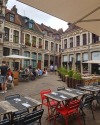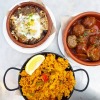After two books focusing on British puddings (Pride & Pudding) and baking (Oats in the North, Wheat from the South), a special interest Downton Abbey Christmas Cookbook, and The National Trust Book of Puddings, Dark Rye & Honey Cake is Belgian food writer, culinary historian and photographer Regula Ysewijn’s first cookbook dedicated to ‘festival baking from the heart of the Low Countries’. The origins, traditions and cultural significance of festive baking recipes are shared across Belgium and the rest of the Low Counties (in which the Netherlands and Luxembourg are also counted) and in this book, Regula explores both sweet and savoury bakes from across the region.

As with her other titles this is a beautiful and captivating book that draws together meticulously-researched history and food culture, sumptiously-styled food photography (photographed by Regula herself), delightful art illustrations (by Regula’s husband Bruno Vergauwen) and a year’s worth of celebratory bakes for festivals including Christmas, Candlemas, Carnival and Kermis (a summer fair), to name a few.
A ringing endorsement from historian Dr Annie Gray in the Foreword is followed by Regula’s introduction in which she relates how she expanded her knowledge of the culinary history not just of Belgium, where she was born and grew up, but also the shared history of the wider region of the Low Countries, and how the region has changed and developed over the last 800 years. There’s a handy map with a reminder that much of the area is at or even below sea level, giving rise to the “low” in the region’s name. Through baking, Regula reveals the heart of the area’s food culture, linking many traditional bakes to the festivals and traditions with which they are associated.
As well as the recipes and traditions themselves, Regula also dived into Flemish and Dutch art; where food was central in so many artworks, often featured in an allegorical way. Some of the historical paintings Regula found most enligtening are reproduced throughout the book.
There is insight too into the languages of the Low Countries, with amusement at the confusion that can arise between Dutch (Nederlands) speakers from the Netherlands, and Flemish (Diets) speakers from Flanders. It puts me in mind of how the UK and America nominally speak the same language but we use it so differently that it can be quite discombobulating! Regula gives us some history of the origins of Dutch, German, French and how these were affected by the changing fortunes in “ownership” of these territories during the colonial era. Religion too played an important role in history and culture. Having spent a number of holidays in Belgium and the Netherlands, I appreciated Regula’s history lesson on how all of these interlinked facets of history lead to the birth of Belgium, and the soft border between Wallonia and Flanders.

Next, an essay on Antwerp: Sugar Capital of Europe: built on a Gallo-Roman settlement, Antwerp became a metropolis of trade and arts and crafts from the 12th through to the 16th century. It’s easy connection to the sea helped forge its importance as a hub for the trading of sugar (which was imported raw and refined in the city), which in turn contributed to the development of baking culture in the area. Wealth generated by the sugar industry lead to the creation of a wealthy middle class, generating trade in other expensive commodities such as high-quality cloth from England, spices from further afield, and all manner of household objects including art and fine tableware. I’ll leave you to learn about the subsequent fall of Antwerp, the rising fortunes of Amsterdam, and the Treaty of Munster yourself, as well as the switch from sugar cane to sugar beets and the development of brown beet sugar.
Recipes are grouped by Celebration and then by type: Waffles; Midwinter and festival bread; Pancakes; Pretzels; Fritters; Vlaaien (pies and filled pastries); Koekebrood (cake bread); and Honey cakes and other sweets. It’s probably no surprise that waffles feature heavily in the book; there are 14 different waffle recipes provided, outnumbered by 16 honey cakes, and 18 pies and pastries! Add to this 12 breads, three pancakes, five different pretzels, five fritters, and one cake bread – I feel like we could put this to a well known tune!

Interspersed between recipes and serving as an extra introduction to the groups of recipes that follow are several essays, the first of which is called ‘The Belgian Waffle’, in which we learn there is no waffle known as such in Belgium! This is immediately followed by ‘From A Hot Iron’, which is all about the history and design of waffle irons. Next, ‘A Midwinter Feast’ prefaces the bread recipes with an explanation of the central role of bread in life, religion and culture, and ‘From White Wheat to Dark Rye’ looks at how your wealth and class determined the kind of bread you could afford. ‘Candlemas and Pancakes’ relates the association of pancakes with Candlemas, which marks the end of the winter season, and ‘Mardi Gras and Binche Carnival’ describes how pancakes are central to these two celebrations also. Continuing on in the pancake theme, we have a profile on ‘Catherine À Doubles’, a woman who became known for the buckwheat pancakes she made and sold in Binche, and a passage and historical recipe for crêpes in the manner of Tournai. The next essay, ‘Krakeling, Bretzel, Pretzel’ focuses on pretzels, telling is about their origins, shape, and names as well as their symbolic relevance and cultural importance today. Before the fritters, pies and pastries we have ‘Sintegreef, the Earl of Laetare’ in which we learn how the margrave (military governor) overcame a local suspicion about the oranges, figs and raisins that arrived in port by distributing the cargo for free, thereby giving Antwerpians a taste of ingredients that quickly became integral to local baking. In ‘Kermis Gastronomy’ Regula shares her memories of going to the Kermis (fairground), before sharing the food items typically sold there. ‘The Clever Cook’ looks at the history of Dutch and Belgian colonists of America, and the enduring impact on the geography, culture and cuisine of the United States. The essay ‘Vlaii’ is altogether more whimsical, relating Regula’s strange dream based on various events of the day including her focus on a painting by Pieter Bruegel called Netherlandish Proverbs – the dream and the painting both feature vlaii (pies) on the roof! The essay does come back down to earth with a more practical examination of these sweet pies and tarts. ‘Two Tarts, One ‘Boulette’ of Cheese’ introduces us to the two key savoury tars of Wallonia, both of which are made with boulette, a crumbly cow’s milk cheese. In ‘American Belgian Pie’ we return to the United States to learn about the history and traditions of a Belgian community in Wisconsin. In ‘Savouring Golden Age Tart’ we learn about the food featured in Dutch and Flemish paintings of the 16th century and what they reveal about material and culinary culture of the era. ‘The Feast of Saint Nicholas’ talks about the real man that gave rise to the myth of Santa Claus, having been known for giving away his fortune to help others, and the changing fortunes of the feast held in his name. The role of sugar is explored in ‘Sweet Tooth’, at first an expensive product that was considered a luxury, but gradually becoming more widely used. Less refined sugar products were obviously cheaper, and thus many recipes made use of syrups made of unrefined molasses. Of course, another sweetener in wide use was wild honey, used in simple cakes such as gingerbread, a topic covered in detail within ‘The Low Countries’ Gingerbread’. I particularly enjoyed the essay on ‘Printing the Dough’, having been so enchanted on holidays to Belgium and the Netherlands by beautifully shaped biscuits made by pressing into elaborate carved wooden moulds. The last essay in the book is ‘A Memory of Flavour and Scent’ in which Regula shares a selection of evocative childhood memories related to food, from the scent of paprika drying in a Hungarian village to the smell of a ripe nectarine taken from a brown paper bag on a warm summer day.
These essays are not the only place to learn about the traditions and stories of baking in the Low Counrties. Every recipe has an in-depth summary that shares more of the rich culinary history that Regula has researched, and which underpins every facet of the book.
Most recipes have photos, styled and photographed by Regula, these are rich and sumptious, with many calling to mind the still-life paintings also shared throughout the book. There are also photographs of the Low Countries, showcasing the place from which the recipes originate.
What delights me about this book is how wide an insight one gains into not only the baking traditions of Belgium and its neighbours but also into the culture, politics, history of the region. We even see how the traditions and food of the area have seeded other countries, travelling with migrants who colonised the “new world”. All of this knowledge is woven into a tapestry of learning that enriches the reader and adds extra dimensions to the recipes themselves



Recipes from Dark Rye & Honey Cake
We have permission from Murdoch Books to share some recipes with you from the book: [coming soon]
If you decide to buy this book after reading our content, please consider clicking through our affiliate link, located at the top of the post and in the footnote.
Kavey Eats was provided with a review copy of Dark Rye & Honey Cake from publisher Murdoch Books.



Please leave a comment - I love hearing from you!4 Comments to "Dark Rye & Honey Cake by Regula Ysewijn"
Wonderful review, Kavey! And it sounds like such an excellent book too – love how it weaves in so much.
This is definitely Regula’s wonderful gift, to weave in so much more than recipes!
I read about this cook book in the WSJ and that article lead me to your review. Your review is like an appetizer and now I’m ready for the meal! I will purchase this book and explore her many other books as well.
Oh that’s lovely to hear, I’m so pleased. You’ll love her other books too, I’m sure!